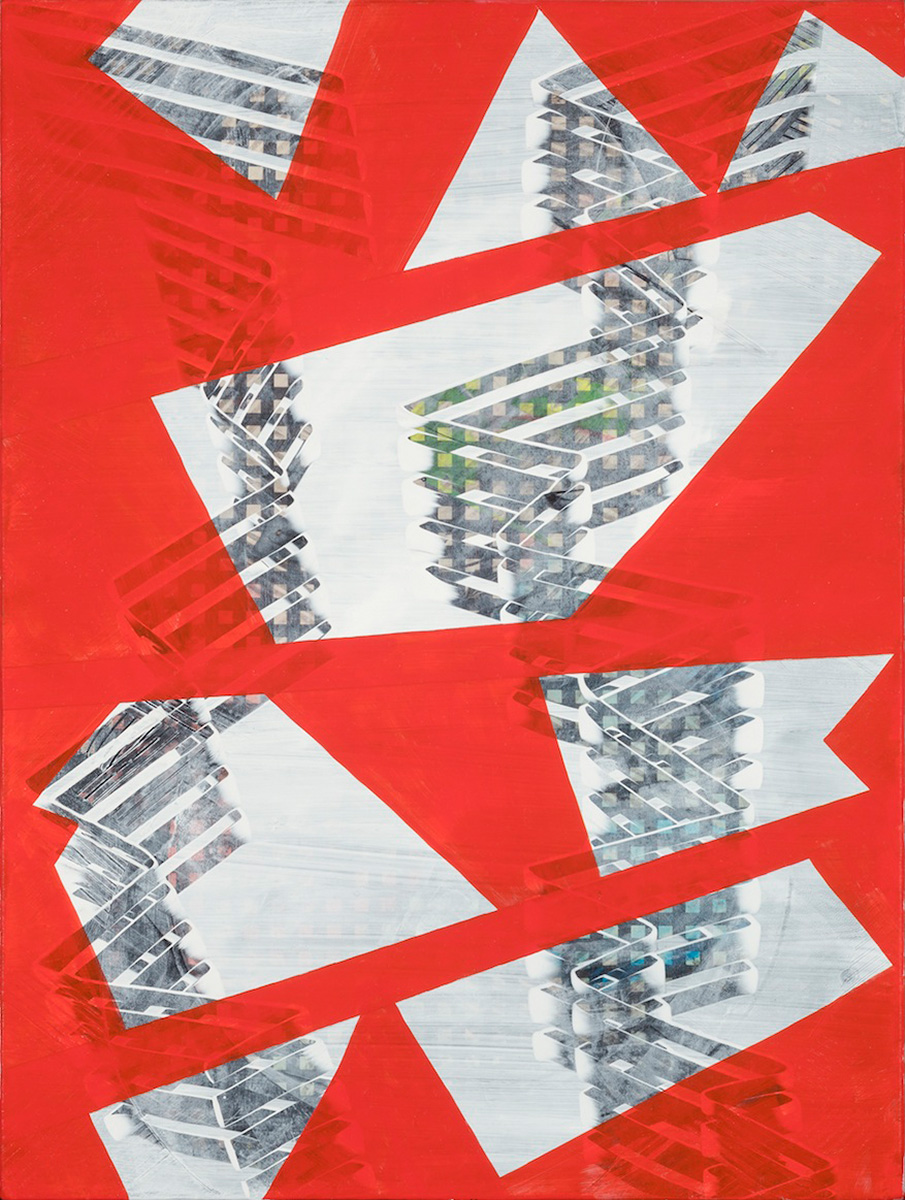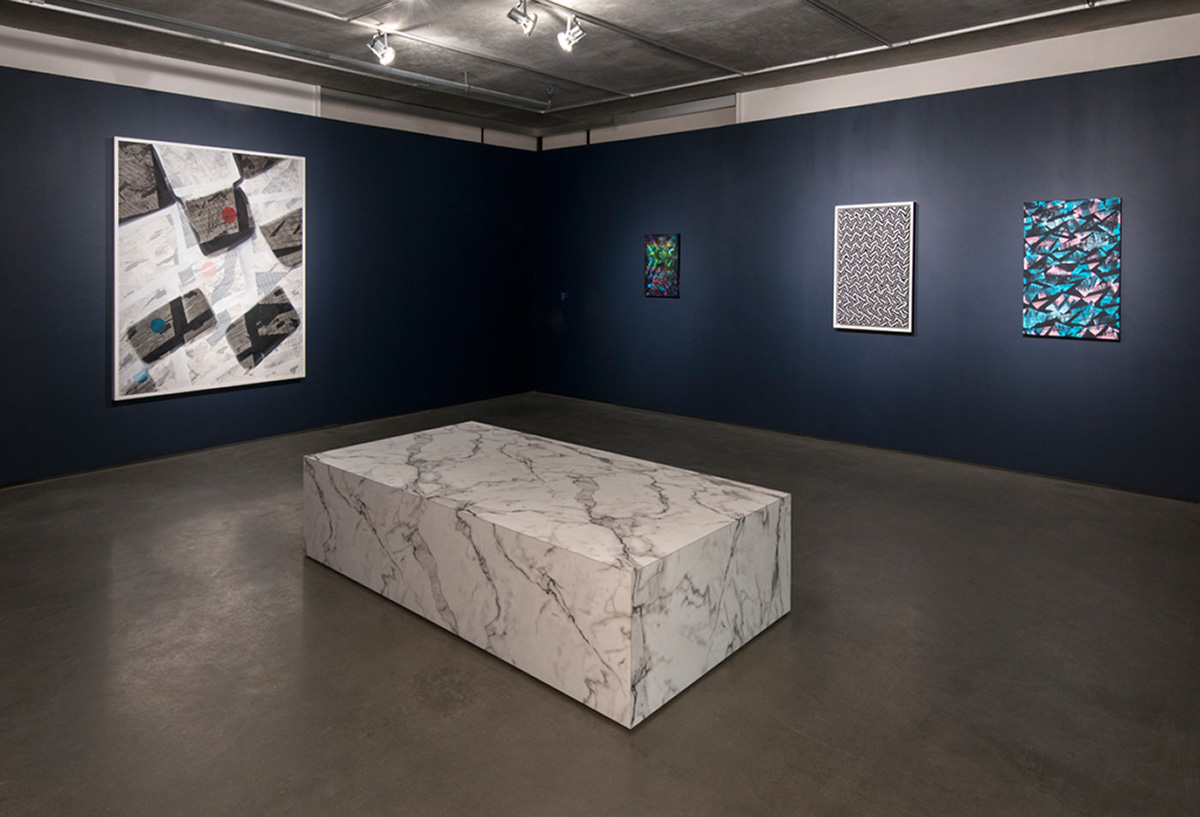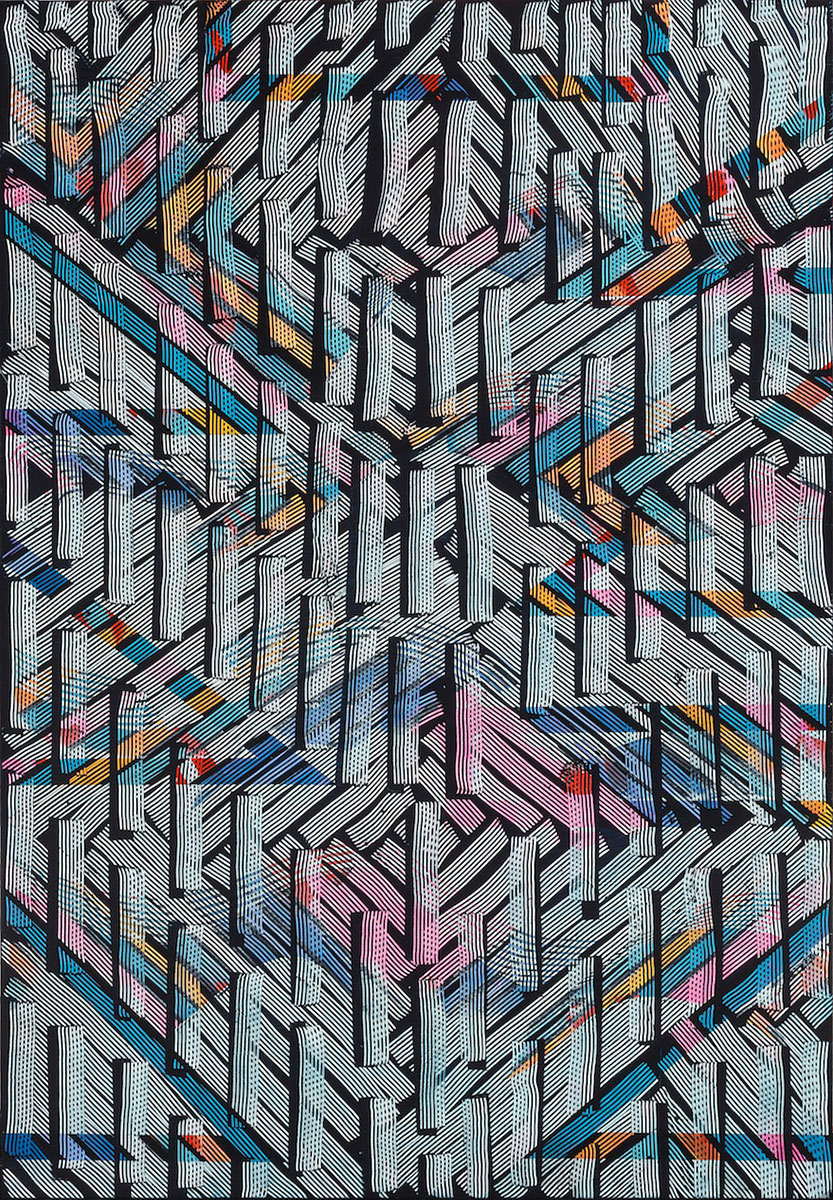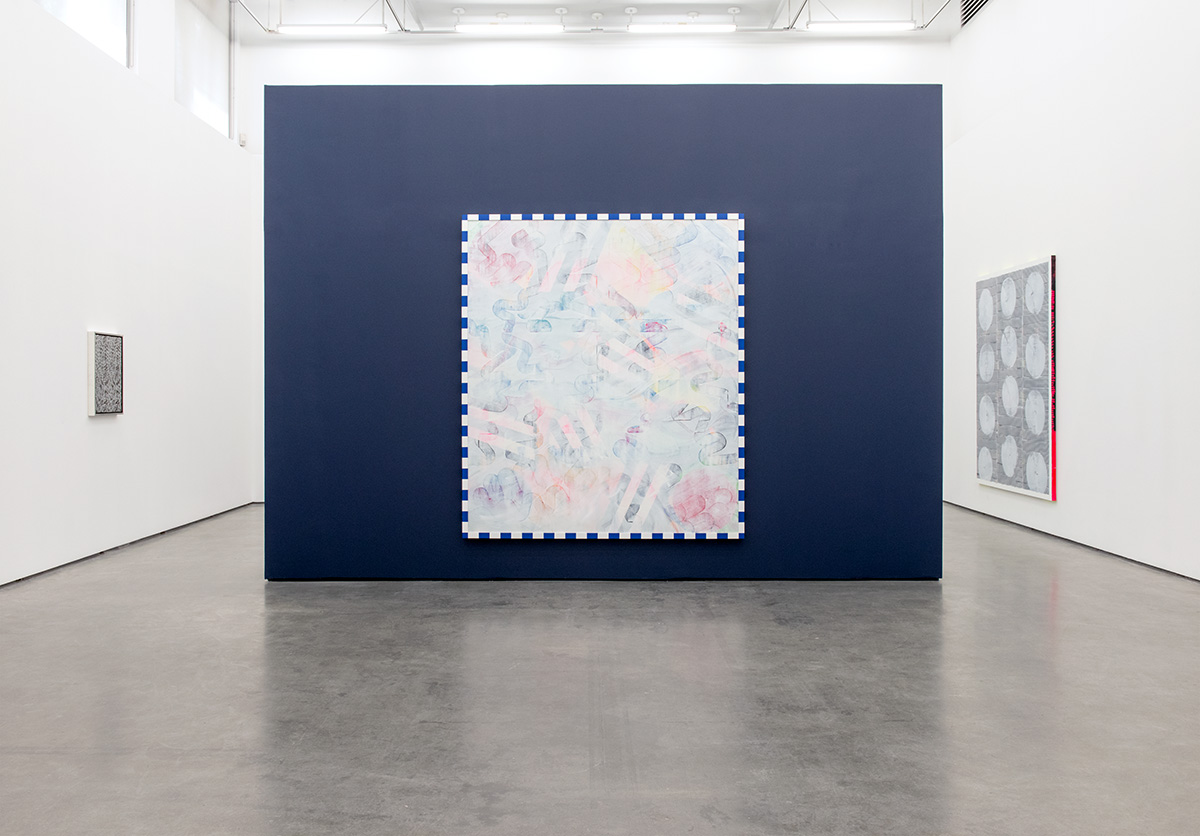Julia Dault’s paintings and sculpture expose the creative act.

Blame It On the Rain, at Vancouver’s Contemporary Art Gallery (CAG), is Julia Dault’s first solo exhibition on the Canadian West Coast. An extension of 2014’s Color Me Badd at Toronto’s Power Plant, it features a selection of the painting and sculpture for which she has received widespread international acclaim in recent years. Dault’s work finds a deft, remarkably effective equilibrium in being just serious enough: it’s playful without being flippant, thoughtful without being pedantic. A labour-intensive, rule-based process and a powerful — and genuinely distinctive — formal aesthetic speak to the earnestness of her intent. Elements like frequently boisterous colours and patterns (that are never true patterns), titles that reference pop culture, and found materials, such as loudly printed spandex, resist over-weighted philosophical readings.
Her paintings are essentially cross-sections of their own creation, with multiple layers made visible through diverse acts of removal and re-adjustment. They can be approached almost like puzzles that tempt the viewer, through close attention, to psychologically reverse-engineer the creative act. Her sculptures, too, via their title cards, orient viewers squarely towards process: they are titled with timestamps of the beginning and end of in-situ combat with big, glossy sheets of Plexiglas and Formica, a battle Dault fights alone, armed with the boxing tape she uses to bind her chosen material into seemingly tenuous submission.
Dault has often cited accessibility as a key concern of her practice. Access is necessarily a mediated proposition. As she works, a sequence of conscious decisions — the act, as she describes it, of making as thinking — determine either directly or indirectly what is ultimately revealed. Though a great deal of information is readily available within the paintings, they are not necessarily entirely decipherable. Based on its particular striations of red, for example, you might suspect that Twizzler (2014) was ‘painted’ using a piece of Twizzlers candy, but without asking, you couldn’t be sure this is the case. (It is.)

If abstract-expressionists sought to drip, smear, and/or gesticulate something of their subconscious ‘selves’ onto a canvas, Dault, as a figure, remains somewhere behind a complex structure of procedures and physical implements that are less responsive to an individual body’s idiosyncrasies than traditional brushes would be. That said, where minimalists often sought to near-erase themselves, Dault’s work clearly points towards its very specific creator. But, a somewhat like a piece of “X was here” graffiti it, again, only offers so much.
Though her artworks are full of her presence, they are not personally revealing; while they are highly communicative, they are not autobiographically emotive. Ideas are given definitive precedence over feelings.
For those who might complain most vehemently about art being inaccessible, hecklers of the infamous my-kid-could-do-that, you’re-just-trying-to-get-a-rise variety, the classic question is not ‘How did you do it?’, but ‘Why would you do that?’. Even if such anxieties were not allayed by a discussion, say, of the cognisant and sophisticated relationship Dault has established between her own body of work and Western art history and theory, many committed contemporary art skeptics would likely be satisfied by very a simple answer here, namely: because it looks so good.
Dault spoke with Vancouver-based arts writer Kyra Kordoski via email and phone earlier this spring while shuttling between her bases in Montreal and Brooklyn as she prepared for her CAG exhibition, which runs until June 28.

Kyra Kordoski (KK): When you begin a painting what kind of sense do you have of how it might turn out? Do you start off with even a general idea, like, ‘this time I want to do something very geometric with black over a lot of blues’, or is it all just one step, one decision, at a time?
Julia Dault (JD): I always improvise in the studio. Each choice of material, colour and gesture grows organically out of the previous one. I sometimes begin with an idea of a particular pattern or palette, but the painting takes over and becomes its own thing. Because I paint in layers, I know what an underpainting may look like, but, of course, ultimately do no know the exact effect the topmost layer will have once applied to the surface of the painting. I don’t plan paintings in advance — I like to simultaneously make and think — since I don’t find the act of simply articulating a predetermined plan that fulfilling. Some of my paintings are framed, and I consider these frames part of the artworks. In those cases, the composition calls out for an enclosure, but this is determined only once I see the final form.
KK: How often are you completely surprised by the results? Or, conversely, do you find you have to consciously keep changing your constraints to stop things from turning out too predictably?
JD: I work with rule sets that determine certain ways of approaching the act of making. These constraints mean that some elements of my practice are fixed. And yet, it is because of these very rules that there is always an element of surprise, which I enjoy, since with each surprise I learn something new.
KK: How much of yourself do you feel is ultimately available to viewers through your pieces? What kinds of things do you think the mark can say about the maker?
JD: I don’t paint my emotions, or make overly grand philosophical claims for the work in an effort to relay a specific worldview to the viewer. (Unlike Barnett Newman, I would never title a painting Vir Heroicus Sublimis.) On the other hand, I also would never outsource fabrication to a foundry, as did many of the Minimalists. Using tools that constrain my hand’s gestures is a way to balance the extremes represented by AbEx painting and Minimalism. I’m definitively the one making the work, but I don’t want the work to be specifically about me.

KK: Is a feeling of balance something you’ve actively worked towards? Was it a starting point for you or is it something that has emerged more in other people’s descriptions of your art?
JD: It depends what you mean by balance. With the sculptures, obviously physical balance — and gravity — are hugely important to the actual functioning of the pieces, given that they are stacked sheets of industrial materials tethered to the wall. My hope is that this balance generates a sense of tension or potential energy. My paintings’ compositions likewise seem harmonious, but the repetition in them is always handmade and therefore imperfect; you can watch a grid of gestures falter as your eyes scan the surface. This disintegration is intentional, since I don’t find perfect, machine-like repeating patterns all that interesting.
KK: Language is so often used to add gravitas to art — with artist statements, press releases, wall texts, reviews and, as you put it, overly ‘poetic’ titles. You use your titles to add levity. They are ‘found’ more than ‘written’ or personally constructed: could that be at all related to a more general sense of needing to take language with a grain of salt, with respect to art?
JD: When titling my paintings, I choose phrases derived from popular culture or from my everyday encounters. They are ‘found’ like other aspects of my art: the industrially produced sheets I will not cut when making a sculpture, the paint that goes unmixed and straight from the tube to the canvas. Since many of the titles derive from the pop culture of the 1980s and ‘90s, viewers who recognize them might feel a particular connection. It’s not a problem if the reference doesn’t resonate — they’re distinct enough from the characteristics of the works that you aren’t missing anything if you don’t know a particular John Hughes movie or pop ballad.
KK: Lastly, could you elaborate on how Blame It On The Rain complements your show at the Power Plant, Color Me Badd?
JD: Although the two exhibitions have fairly distinct checklists both survey my recent work, so there are links among the individual pieces. And, in each case, I’ve tried to create a unique set of display strategies that respond to the characteristics of the galleries. In Toronto, I created an eighty-foot-long wall piece that traversed, and linked, two very different gallery spaces. In Vancouver, I carry a very particular — and unusual for contemporary art — wall colour from the smaller gallery into the larger one, with a mirror-lined threshold linking the two.
The Contemporary Art Gallery in Vancouver hosts Blame it On the Rain, a survey of Julia Dault’s recent work, until June 28.
Kyra Kordoski is writer based on the Canadian West Coast. Her work has been published in several arts publications, including C Magazine, White Fungus, BOMB, and Paperwork Magazine.



